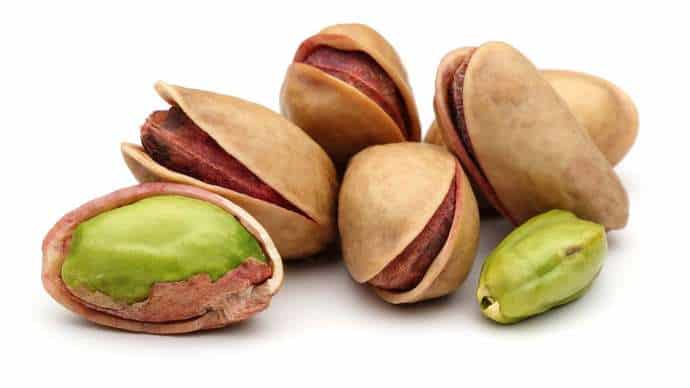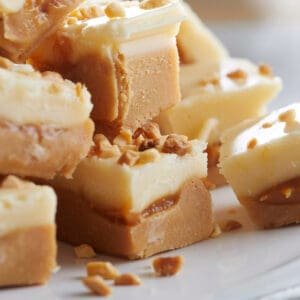National Pistachio Day – Saturday, 2/27

Happy National Pistachio Day from your friends at E.O.D Confections! Just when you thought you knew your Nuts, the pistachio isn’t a nut at all! And that’s nuts! Read on for more…
Technically, it’s a “drupe,” a fleshy tree fruit that contains a shell-covered seed…how bizarre, right? With pistachios we discard the fruit flesh for the tasty seed within. With other drupes such as peaches, cherries and apricots, we eat the fruit flesh and leave the pits, for the most part, behind. See, you probably just learned something new you didn’t know you needed to know (more mind blowing history to come)!
The pistachio belongs to a group of drupes called “culinary nuts” that include cashews and almonds. A real nut, also called a “true nut” or a “botanical nut,” is not a fruit but rather a seed encased in a hard, woody shell. This group includes favorites such as hazelnuts, chestnuts and acorns (although acorns are best left to the squirrels in my book lol).
The pistachio tree originated in western Asia, and archaeologists believe pistachios became a food as early as 7,000 B.C. In fact, some date its’ roots as far back as 116 B.C. and the Roman Empire. Marco Terenzio Marrone wrote of a sweet called “Cupedia” made from honey and almonds but harder like brittle (similar to my recipe below, but it’s not brittle, just scrumptous). There are also references from around the third or fourth centuries AD in one of the oldest known cookbooks, “De Re Culinaria”, of a ‘sweet’ made of honey, egg whites, and nuts.
Pistachios came to the United States in the mid-19th century and commercial production began in the 1970s (wow, we were late to the game), when our domestic production found its feet. This was done was through the efforts of botanist William E. Whitehouse, who began importing and experimentally planting pistachio trees in the 1920s. Today, California, where those original plantings were established, is responsible for 99 percent of our domestic production, with the other 1 percent coming out of Arizona and New Mexico. The production of pistachios has exploded over recent decades and the U.S.A now produces over 80 million pounds of the nuts per year, enough to fulfill our domestic market and export product around the world. Who knew? I always like to give some history along with the recipe so it’s a fun way to engage with your children in the kitchen, and teach them more than just the recipe. Kitchen time is a memory that stays into adulthood. Make it fun and learn a thing or two along the way (BTW, partners are an excellent choice if you don’t have kids).
What to Look for When Buying Pistachios – DON’T BUY RED ONES!! Ever see red pistachios? Before the hard work of Mr. Whitehouse, pistachios were often died red to hide the blemishes incurred during transport! And red dye is just bad – don’t do it!
On the tree, pistachios are wrinkled fruits that grow in heavy clusters reminiscent of a bunch of grapes. The husked fruit contains a thin, ivory-colored, bony shell that splits longitudinally along their sutures when mature. Inside the shell is the kernel — what we refer to as the nut. The kernel ranges in color from yellowish to bright green, the more prized specimens being the more vibrantly hued. So you want to buy the ivory colored shells and say no to the red shells!
Storing Pistachios…Check out my latest vlog on TikTok https://vm.tiktok.com/ZMeYBXDyt/and InstaGram https://www.instagram.com/p/CK-Jk8Pj_Bj/?igshid=1tzy1ixc4bwdq for the funny and “spicy” version of this (if you need a good laugh…click the link(s) and I dare you to try to keep a straight face!). Now back to the family friendly version of proper storage of nuts: Stored in plastic bags, roasted pistachios will last for about a year in a cool dry place. Nuts gets rancid over time (and rancid nuts are really smelly!), so it’s important to rotate your pantry supply to ensure freshness.
Cooking with Pistachios – Pistachios are often eaten out of hand and are sold in their shells for snacking.
Shelled, unsalted pistachios are preferred for cooking. They are delicious in desserts, such as my favorite, Torrone. It’s an Italian candy dessert that I love to make and I’m happy to share it with you!
Torrone – Classic Italian Nut and Nougat Confection – full recipe below…
Made with just a few simple ingredients, basically just honey, egg whites, and nuts such as almonds (or Pistachios), Torrone is a favorite Italian confection of mine. Coming from the Latin ‘torrere’ which means to toast because of the toasted nuts, this nougat cousin is made in many variations and by different names around Italy, but also all around the Mediterranean, Spain, France, North Africa, the Middle East, and as far as China.
Torrone is traditionally served as the last dish during Christmas dinner (but who wants to wait until Christmas?) and Torrone itself is thought to have been created, as legend goes, for the wedding of Bianca Maria Visconti and Francesco Sforza, later the Duke and Duchess of Milan; for the ceremony on October 25th, 1441, in Cremona, Italy The pastry chefs made a sculpture resembling the town’s tower, the “Torrazo.”
Whatever the origin, wherever it came from, or whomever invented it, I’m glad it is still around! The following recipe is a pistachio version. Torrone can vary from firm to soft, but this one has a nice, subtle chew. Flavorless sheets of edible wafer paper keep the strips from sticking to one another. This recipe is a bit on the intermediate side but well worth the extra effort, especially if you take the extra step and enrobe the final product in your favorite chocolate after! Candied orange peel or other candied fruits do very well in this recipe as well.
Pistachio Torrone – Active time: 45 min. Start to finish: 1 day (includes setting time). Servings: Makes about 3 dozen candies
Ingredients:
1 1/2 cups clover or other mild honey
1 1/2 cups sugar
1/2 cup water
3 large egg whites
1/4 teaspoon salt
1 1/2 teaspoons orange-flower water
3/4 teaspoon pure almond extract
2 1/2 cups salted roasted shelled pistachios (5 ounces)
1 tablespoon cornstarch plus additional for kneading
Equipment: an 8-inch square metal baking pan; a candy thermometer; a heavy-duty stand mixer fitted with whisk attachment; edible wafer paper
Directions:
Oil baking pan, then line bottom and sides with pieces of edible wafer paper, trimming it to fit.
Heat honey, sugar, and water in a 5-quart heavy pot over low heat, stirring, until sugar has dissolved, then bring to a boil over medium heat, without stirring, washing any sugar crystals down side of pan with a pastry brush dipped in cold water. Put thermometer into syrup and continue boiling, stirring occasionally, until it registers 310 to 315°F (upper end of hard-crack stage).
When thermometer reaches 300° (149°C), start beating egg whites with salt in mixer, beating until they hold soft peaks. Remove syrup from heat and let stand until bubbles dissipate.
With mixer at low speed, slowly pour hot syrup into whites in a thin stream down side of bowl. Increase speed to high and beat until mixture has cooled to warm (mixture will rise, then fall), about 20 minutes. Add flower water and almond extract and beat 1 minute more. Stir in pistachios.
Sprinkle a work surface with cornstarch (1 tablespoon), then spoon torrone mixture onto cornstarch and gently knead a few times with hands dipped in cornstarch.
Pat torrone mixture into baking pan and top with a square of wafer paper, trimming to fit. Let stand at room temperature at least 8 hours.
Run a sharp thin knife around edges of pan, then invert torrone onto a cutting board. Leaving wafer paper on, trim ends and cut torrone into 1-inch-wide strips. Wrap each torrone strip in parchment paper. (If desired, cut each strip into 2-inch rectangles.)
Torrone keeps in an airtight container in a dry place at cool room temperature for 2 weeks.
If you give this one a try, let me how it goes!
And if you’re NUTS for NUTS…be sure to try E.O.D’s Sea Salt Gophers, made with delicious Georgia Pecans overflowing with a special caramel recipe, then topped with our signature dark chocolate hand swirl. Use code GOPHER10 for 10% off at checkout. Dark Chocolate Sea Salt Gophers and all our luxurious and delectable treats are available at our website https://eodfudge.com

Extra Ordinary Delights




